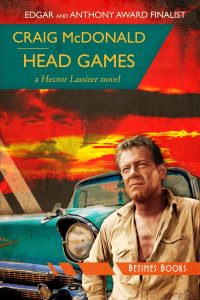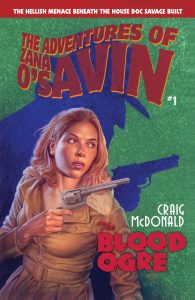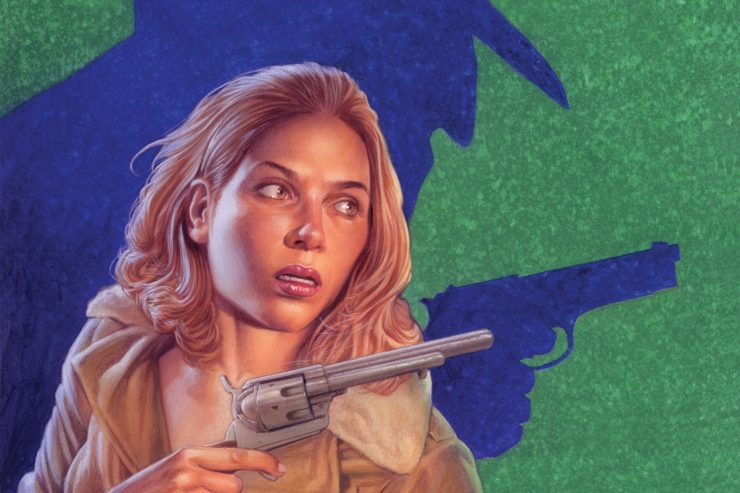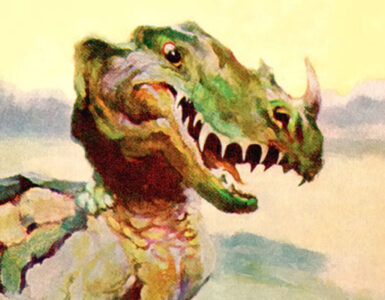Pulp magazines have influenced writers, artists, film directors, software developers, and countless others over the years. Our “PulpFest Profiles” focus on contemporary creators who have drawn inspiration from these rough-paper fiction magazines.
 William Patrick Maynard (WPM): Craig McDonald stands out among contemporary pulp writers because of his polished and highly literate prose. Much like Hammett and Chandler during the Golden Age of Pulp, Craig McDonald’s work rises to the top because of its distinctive style and his mastery of both language and character.
William Patrick Maynard (WPM): Craig McDonald stands out among contemporary pulp writers because of his polished and highly literate prose. Much like Hammett and Chandler during the Golden Age of Pulp, Craig McDonald’s work rises to the top because of its distinctive style and his mastery of both language and character.
A talented writer, a keen student of history and observer of the human condition, Craig McDonald belongs to the rarified strata of writers whose name has become synonymous with consistent quality. Let’s start at the beginning. How did you go from reader to writer and what were your key influences along the way?
Craig McDonald: The first book that really seized me was a Bantam paperback reprint of the second Doc Savage pulp novel, The Land of Terror, given me by my grandfather. He was an ironworker in New York City during Doc’s 1930s pulp heyday, and so knew the character from his youth. By third grade, I was trying to write my own fiction. As a reader, I continued along with Doc, The Shadow, and The Avenger book reprints, made the jump to Hammett and Chandler, and then to Hemingway. These, along with Ian Fleming, I count as my greatest early influences. I skipped all the usual stuff of that era, such as the Hardy Boys and similar YA series.
WPM: You’ve accomplished so much with the award-winning Hector Lassiter series. After twelve books and a graphic novel, I’m pleased to learn you’re not quite done with the character. Tell us how the character developed and if you always hoped he would become a recurring character.
Craig McDonald: Around 2005, The Mississippi Review posted a call for short stories for a themed collection of “High Pulp.” The idea was to write something in classic pulp tradition but with a literary undertow or spine. My story, “The Last Interview,” made the cut and then was anthologized a couple of times. It was a version of the Lassiter character, on his death bed, being interviewed by an unworthy journalist. It morphs from that to a locked room mystery and sort of noir, through-the-looking glass spin on Hemingway’s Snows of Kilimanjaro. In it, Doc Savage, The Shadow, and their primary authors, Lester Dent and Walter B. Gibson, are name-checked. It was a one-off, but then I had the idea for a couple of linked novels for which a different version of the Lassiter character proved the perfect protagonist. A multi-book series with a larger arc for the Lassiter character, who is a Black Mask author turned crime novelist, was the result.
WPM: You have also done quite well with the Chris Lyon series of thrillers which are part of a shared universe — to utilize the irritating vernacular of the moment — with the Hector Lassiter series. Tell us how these four . . . really five . . . titles developed alongside the Lassiter books and how they maintain a distinct identity.
Craig McDonald: The Lyon novels were my first crack at a crime series. They were also contemporary (at the time, written in the late 1980s – early 1990s), while the Lassiter novels spread across the entirety of the 20th Century and Lassiter ages in real-time. The cross-point or nexus for the two series was a Cleveland-based Irish cop created for the first Lyon novel, Parts Unknown, and the notorious cycle of serial murders committed in Cleveland, the “Torso Slayings,” AKA, “The Mad Butcher of Kingsburg Run.” These were investigated by the legendary Eliot Ness when he was serving as Cleveland Safety Director, after his Capone years. I actually have more Lyons written, but they got kind of dry-docked as the Lassiter series came into being. In my earlier days, I tended to write about two to three manuscripts for every one published. Later, I used a pen name to get some of those works out since I was usually limited to one book-in-a-calendar-year by my various publishers.
 WPM: Your latest project is The Blood Ogre, a meta-fictional work about Doc Savage creator Lester Dent and The Shadow author Walter Gibson. It’s also a book that introduces your take on Pat Savage, Zana O’Savin. Tell us how the book came to be, how it also connects with Hector Lassiter, and how your Pat Savage differs from the canonical one or, for that matter, the Phil Farmer and Win Scott Eckert take on the character.
WPM: Your latest project is The Blood Ogre, a meta-fictional work about Doc Savage creator Lester Dent and The Shadow author Walter Gibson. It’s also a book that introduces your take on Pat Savage, Zana O’Savin. Tell us how the book came to be, how it also connects with Hector Lassiter, and how your Pat Savage differs from the canonical one or, for that matter, the Phil Farmer and Win Scott Eckert take on the character.
Craig McDonald: The Blood Ogre could easily have been my first fully completed novel back in the 1990s (the idea goes back to the 1970s). But the Doc Savage pulp paperback reprints were still going strong at the time, as well as comics, and there didn’t seem to be room for that kind of novel. Then along came Paul Malmont’s Chinatown Death Cloud Peril at just about the time my first Lassiter novel, Head Games, was approaching publication.
The idea for Ogre actually came to me as a kid, when I read a tabloid account of the so-called “Ghost of Gay Street” a Shadow-like figure being spotted around an old brownstone in Greenwich Village. Turns out, the joint in question was the very place Gibson lived and wrote the last of the Shadow pulp novels. Gibson postulated in the article his intense creative effort generated a mind projection or tulpa, of Lamont Cranston/The Shadow. The Lassiter intersection arose again because Dent crops up in a novel called The Running Kind, and Dent and Gibson are on-the-page characters in a story within the Lassiter anthology, Write from Wrong. The character of Bud Fiske, our “proxy” hero in The Blood Ogre, is Lassiter’s sidekick across several of the novels in that series and the graphic novel of Head Games.
As to Pat Savage, my goal with this novel, and any that follow, is to deepen the characters and make them more fully rounded than they appeared in the pulps. Ideally, character should drive plot and plot should simultaneously evoke character. Frankly, not much of that happens in the original Doc Savage novels. As to how this compares to other versions of Pat, there seems to be a tendency for others tackling the character to lean into sexualizing and eroticizing her, something I’m not interested in doing in the O’Savin novels. The cover of the first novel has Zana/Pat bundled up in a fleece-lined aviator’s jacket. What you won’t see is a Zana cover with her in a strategically torn shirt with nothing underneath, which has become commonplace in many Pat depictions in comics and fan-commissioned artwork, particularly.
WPM: Zana O’Savin is set to return in The Mothman Menace. Do you envision more titles with the character? Will the books continue to be meta-fictional? Is the line between story and storyteller something you would be interested in blurring with your own characters?
Craig McDonald: As long as there is reader interest in them, I’m not setting any limits. The possibility also exists to further explore the other two major pulp characters who are given pastiche attention in The Blood Ogre — that of the Shadow-like character, and the other riffing on The Avenger. The way the over-arching meta pulp concept is set up, the sky is the limit. That said, The Blood Ogre was about world-building and is a novel about pulp literature. The Mothman entry, which is nearly completed, is more of a pulp novel if that makes sense. It is more in the vein of classic pulp but with a historical bent, which may be the trend for the rest in the series. I have ideas for several books with these characters, but again, it will depend on their traction with readers.
WPM: I wanted to make sure we discuss your non-fiction work since both Art in the Blood and Rogue Males are excellent resources, very much in line with Backstory for screenwriters. In their own way, these do for the living what your meta-fictional and historical fiction does for authors of the past. Tell us about these books.
 Craig McDonald: In my middle-journalism days, I more or less found myself pushed away from writing and more into management. I started interviewing authors as a means of giving myself something that interested me, that allowed me to write, and also to more or less get an informal education on the craft and business of fiction from a range of top writers. I have a third volume I put together years ago, but it just never got out there. The two books are now sufficiently in the rearview mirror that a fair number of the authors profiled have, I’m sad to say, passed.
Craig McDonald: In my middle-journalism days, I more or less found myself pushed away from writing and more into management. I started interviewing authors as a means of giving myself something that interested me, that allowed me to write, and also to more or less get an informal education on the craft and business of fiction from a range of top writers. I have a third volume I put together years ago, but it just never got out there. The two books are now sufficiently in the rearview mirror that a fair number of the authors profiled have, I’m sad to say, passed.
WPM: Craig, what other ambitions do you yet to fulfill?
Craig McDonald: Tough one. I’d love to have a shot at writing a licensed James Bond novel. That would be a dream come true. I deeply miss the character as written by Fleming.
WPM: Craig, you have distinguished yourself as an author, historian, and scholar. Every project you take on is greeted with tremendous interest because of the passion and quality you deliver time and again. This interview, like our conversations, has been a true pleasure. Thank you, most sincerely for being part of this “PulpFest Profile.”
Craig McDonald: Thank you for the too-kind words, William, and for being such a talented and passionate interviewer. Talking author-to-author with you is always a privilege and a pleasure.
Author of the Edgar-nominated Hector Lassiter historical crime series, Craig McDonald is an award-winning novelist, journalist, and editor. The Hector Lassiter series chronicles the exploits of a fictional Black Mask author and his encounters with such notable figures as Ernest Hemingway, Orson Welles, Ian Fleming, and Lester Dent. McDonald’s internationally acclaimed works have found a global audience and have also been adapted in graphic novel format. His works have been published by Simon & Schuster and Macmillan Press.
Head Games was the first of Craig McDonald’s Hector Lassiter novels. Originally published by Bleak House Books in September 2007, Head Games was selected as a 2008 Edgar Award nominee for Best First Novel by an American Author. Reprinted by Betimes Books in 2015, the new edition features a cover designed by Finnish-American designer, editor and writer JT Lindroos. Head Games has also been adapted as a graphic novel, with art by Kevin Singles.
A haunting mix of history and meta-fiction centered on the very act of literary creation, The Blood Ogre introduces Zana O’Savin, Craig McDonald’s version of Doc Savage’s cousin Pat. Available in both hardcover and trade paperback from Amazon, it features front cover art by Chicago-based artist and illustrator Doug Klauba.
Want to learn more about Craig McDonald and his work? His official website is at craigmcdonaldbooks.com. He’s also on Facebook, Instagram, and Twitter. And don’t forget to subscribe to his official YouTube channel. A member of the PulpFest organizing committee, you can read more about Craig on our PulpFest Committee page.
The licensed continuation author for the Sax Rohmer Literary Estate, William Patrick Maynard’s fiction has also been published in anthologies by Airship 27, Bold Venture Press, Black Coat Press, Flinch Books, MX Books, Riviere Blanche, and Titan Books. He has authored over 250 articles for numerous magazines and websites. He has contributed Blu-ray commentary tracks and produced bonus features for releases by MGM, Shout Factory, Kino Lorber, and The Serial Squadron. Bill is on the editorial board of The Battered Silicon Dispatch Box and is a member of the PulpFest Organizing Committee where he serves as Assistant Director of Marketing and Afternoon Programming Director. He resides in Northeast Ohio and regularly contributes to our website.
Watch for our next PulpFest Profile on November 14 when Craig McDonald will talk with new-pulp fiction author and illustrator Sara Light-Waller, winner of the 2020 Cosmos Prize for her illustrated short story, “Battle at Neptune.”






